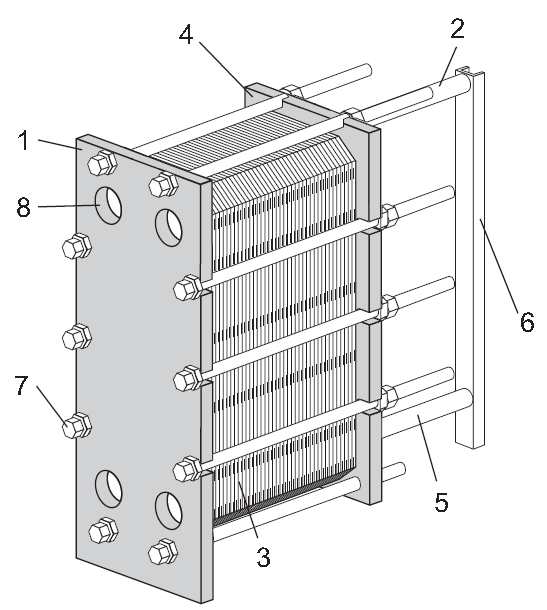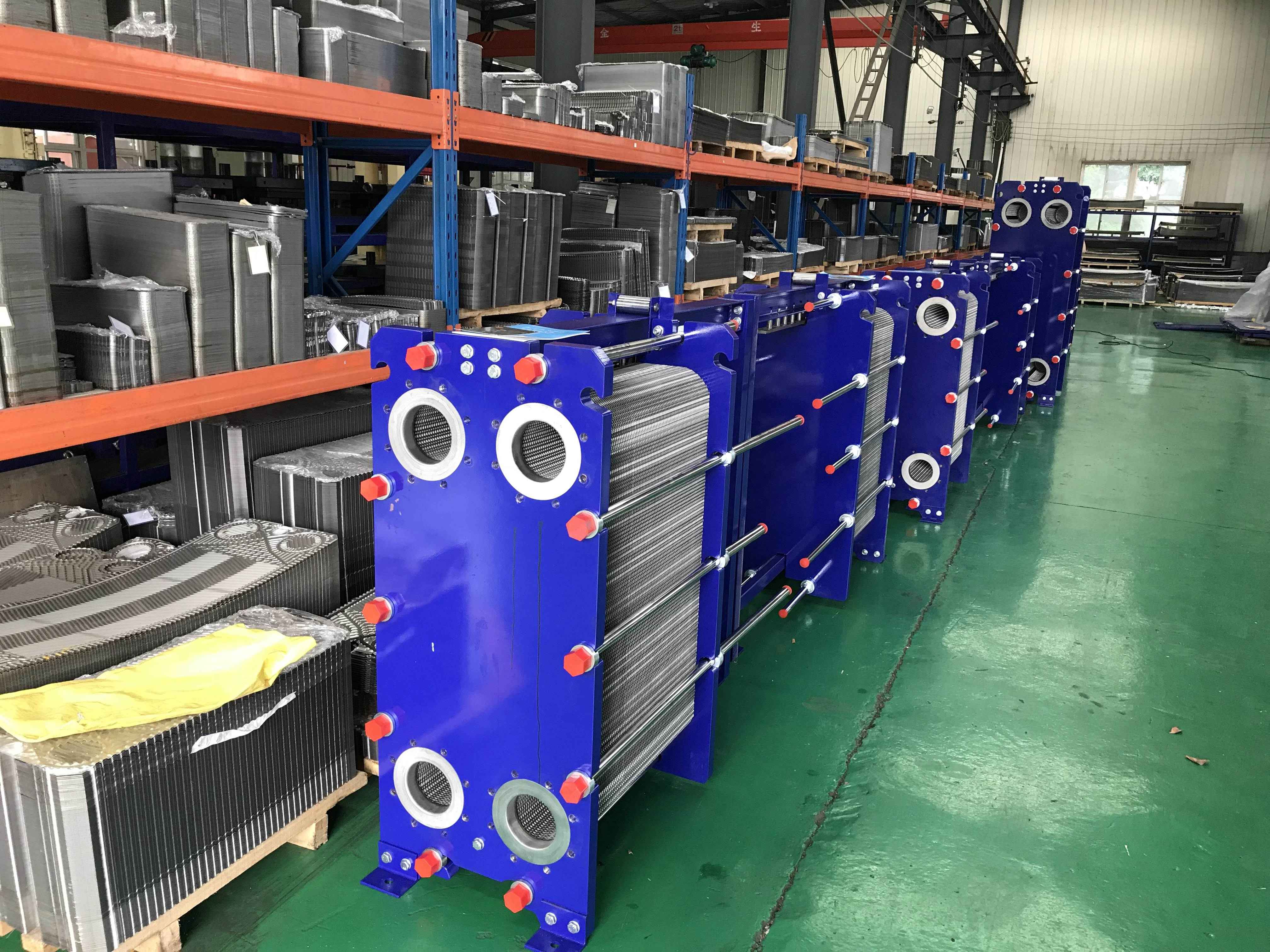Detailed structure and component analysis of plate heat exchanger
The plate heat exchanger is mainly composed of the following 8 parts:

1. Fixed clamping plate
Fixed plates with different numbers of interface holes for connecting to the piping system. Upper guide bar and lower guide bar
Connect to the fixed plate.
2. Upper guide rod
Carrying plate group and pressing plate.
3. Plate group
Heat is transferred from one medium to another through the plates. The plate group consists of grooved plates, end plates, and gaskets
And transition board (in some cases). The measurement data of the plate group is the size A, that is, the fixed plate and the pressure
Measurement data between tight plates. Refer to the drawing of the plate heat exchanger.
4. Active compression plate
The removable plate can contain various interface holes for connecting to the piping system.
5. Lower guide rod
Keep the bottom ends of the grooved plate, connecting plate and compression plate aligned.
6. Pillar
Support the upper and lower guide bars.
7. Fasten bolts
Press the plate group between the fixing plate and the pressing plate.
The bolts with bearing box are fastening bolts.
The remaining bolts are used as locking bolts.
8. Interface corner hole
The interface hole through the fixing plate allows the medium to enter or exit the heat exchanger.

In addition, we have some other optional parts. They are:
• Stud bolt
Threaded studs around the interface holes secure the flange joint to the device.
• Partition
Rugged carbon steel plates used in multi-process configurations. Reinforce the steering plate when needed.
• Support feet
Provides stability and is used to bolt the heat exchanger to the base.
• protecting mask
Cover the plate group to avoid high temperature or aggressive liquid leakage or (personnel) contact with the high temperature plate group.
• Bolt protector
A plastic tube used to protect the thread of the fastening bolt.
• Insulation
For applications where the temperature on the surface of the heat exchanger is too high or too low, an insulation layer can be used.
• Lifting device
A separate device installed on the heat exchanger for lifting the heat exchanger.
• Ground lug
The ground connection can be used to eliminate the risk of static buildup in the device.
• Interface cover
Protective device to avoid particles entering the heat exchanger during transportation.
• water tray
Depending on the type of fluid in the heat exchanger and the type of installation, a water tray (drain tank) may be required to avoid
Personal injury and equipment damage.
• Lifting or transporting fixtures
A locking device fixed between the fixing plate and the pressing plate.
The above is the most detailed explanation of the structure of the plate heat exchanger. If there are other structural problems, please pay attention to consult us.
Related information
- Pharmaceutical industry-specific double-walled plate heat exchanger advantages too many to count
- To choose a plate heat exchanger manufacturer in the pharmaceutical industry, look for Qingdao RPT
- How to choose the right plate heat exchanger
- Analysis of the material and application scope of the most complete plate heat exchanger gasket in history
- Causes of heat exchanger gasket aging
- A special plate heat exchanger for heat transfer in the health field meets your extreme imagination in this factory
Relevant article
- 1
- Can plate heat exchanger be directly used for feed water heating or cooling?
- Why the heat transfer efficiency of plate heat exchangers in the heating industry is low
- How to determine the size and angle of plate heat exchanger plate?
- What is the proportion of pressure drop in the selection of plate heat exchanger?
- Why do we recommend food grade plate heat exchanger for beer brewing and fermentation? What should we pay attention to?
- What is the difference between the hanging holes on the plate of plate heat exchanger?
- What are the applications of plate and shell heat exchanger in the field of petroleum refining
- What is the key to the manufacture of plate heat exchangers with small temperature differences?
- How to descale the plate heat exchanger? What problems should be paid attention to during use?
Latest information
- Heat station supporting plate heat exchanger installation is a technical work, these points should be noted
- Sulfuric acid and other corrosive media for industrial plate heat exchanger requirements are what
- Simple and effective chemical cleaning method of coal chemical plate heat exchanger, can effectively improve efficiency
- A high-quality petrochemical plate heat exchanger in the production of what to consider
- These causes of chemical plate heat exchanger gasket aging you may not know
- Chemical plant plate heat exchanger, sulfuric acid cooling needs attention
- High-end plate heat exchanger customization, specifically for your special working conditions
- The working principle of gasket type industrial plate heat exchanger and the scenarios of its use are worth knowing in depth
- Still worrying about the wholesale price of industrial plate heat exchangers? An article to make you no longer tangled
- The original lubricant in the chemical plate heat exchanger plays so many roles!








